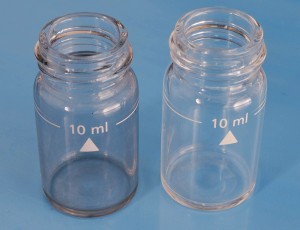You probably know that most chlorine, ozone and chlorine dioxide analyzers are calibrated using hand held DPD kits but did you know that…
…DPD can’t tell you when you have no residual?
…errors on DPD performance can be up to ± 100%?
…a significant number of service calls received by Pi relate to poor calibration?
What is DPD?
DPD (N.N-diethyl-p-phenylenediamine) is a chemical that when mixed with water containing an oxidant, changes color depending on the concentration of the oxidant present. A handheld colorimeter measures light passing through the colored solution. The absorption of that light by the liquid gives a concentration value. It is usually used to check concentration of, for example, free chlorine, total chlorine, ozone and chlorine dioxide etc. in water.

DPD vials containing water samples with oxidant (right) and without oxidant (left)
When the DPD kit gives a value, it is often used to calibrate online instruments… and that is where Pi comes in!
As a manufacturer of online instruments we have to understand DPD in order to help our customers when they have problems calibrating their online monitors.
This Focus On will look at:
- The limitations of DPD (turbidity, zero oxidant, bleaching, pH and interferents).
- Minimizing DPD measurement error (sampling, alignment and cleaning).
- Things to look out for (low concentrations, pink color, stained glass).
- Little known chemistry (measuring bromine, chlorite versus chlorine dioxide).
- Rinse and repeat: is it really worth repeating my measurement?
What are the limitations of DPD?
DPD cannot measure below approximately 0.05 ppm.

DPD vials containing water samples with (right) and without (left) trace amount of oxidant
If you suspect there is zero oxidant in your sample, hold the vial up to a white surface. If you cannot see any trace of pink color, it is likely any reading you are getting is from the unreacted DPD tablet.
DPD cannot measure free chlorine above 6ppm
(and won’t always give a ‘high concentration’ reading error).
Many people are unaware that past a certain level of oxidant, DPD will not form its characteristic pink color, and instead will ‘bleach’ to form a clear solution. This can lead people to think there is little or no oxidant in their water, when in fact there is so much that it is bleaching their DPD. Be on the lookout for a flash of pink when the tablet or powder is added if you suspect your sample is being bleached. NB. special kits and reagents are available for measuring oxidant above 6 ppm.
DPD cannot distinguish between oxidants such as:
chlorine, chlorine dioxide, chlorite, ozone, organochlorides, bromine and more, meaning interferents are a big problem.
DPD is a fantastic chemical, in that it is very versatile as a coloring agent, which is how it gives the oxidant the color that we measure. This versatility does come at a price, DPD is not very specific as an analysis tool, and so if other chemicals are present in the sample, they can interfere with the reading, giving an inaccurate result. Common interferents include chlorine dioxide (for chlorine measurement, and vice versa), sodium chlorite, ozone, organochloramines, peroxides, and many more.
Minimising DPD measurement error
Here is an easy to read, printable checklist to ensure accurate DPD readings every time.
What To Watch Out for When using DPD
Stained Glass

DPD vials with staining (left) and without staining (right)
The pink solution formed after DPD tests can leave a residue behind on the glass, which will affect the DPD reading. This residue can be easily cleaned off using what is in your DPD kit.
Tap water
If you use normal tap water to wash out vials, droplets left behind can affect your reading due to the residual chlorine in drinking water. It is best (but not always practical) to use deionized water to wash out your vials, but if this isn’t available (deionized water can be purchased as car battery top up water from any car parts supplier) then you can use cooled boiled tap water, as boiling gets rid of any chlorine. If not then simply make sure the vials are perfectly dry before use.
Little Known Chemistry
DPD has a wide range of interferents. This means recurrent problems can sometimes be caused by the chemical makeup of the sample. For example, chlorite (ClO2–) and chlorine dioxide both affect DPD, but only chlorine dioxide is measured by most chlorine dioxide amperometric sensors.
DPD can be used to track bromine, but DPD No.1 tablets measure FREE chlorine or TOTAL bromine. As combined bromine is just as effective a disinfectant as free bromine, this generally doesn’t pose too much of a problem, however some amperometric sensors measure free bromine, and cannot be calibrated using DPD No.1 tablets. For more information on measuring bromine, or chlorine in seawater, please see Pi’s technical note on Seawater Chlorination. Manganese and iron are both interferents with DPD and both are often present in drinking water treatment plants.












